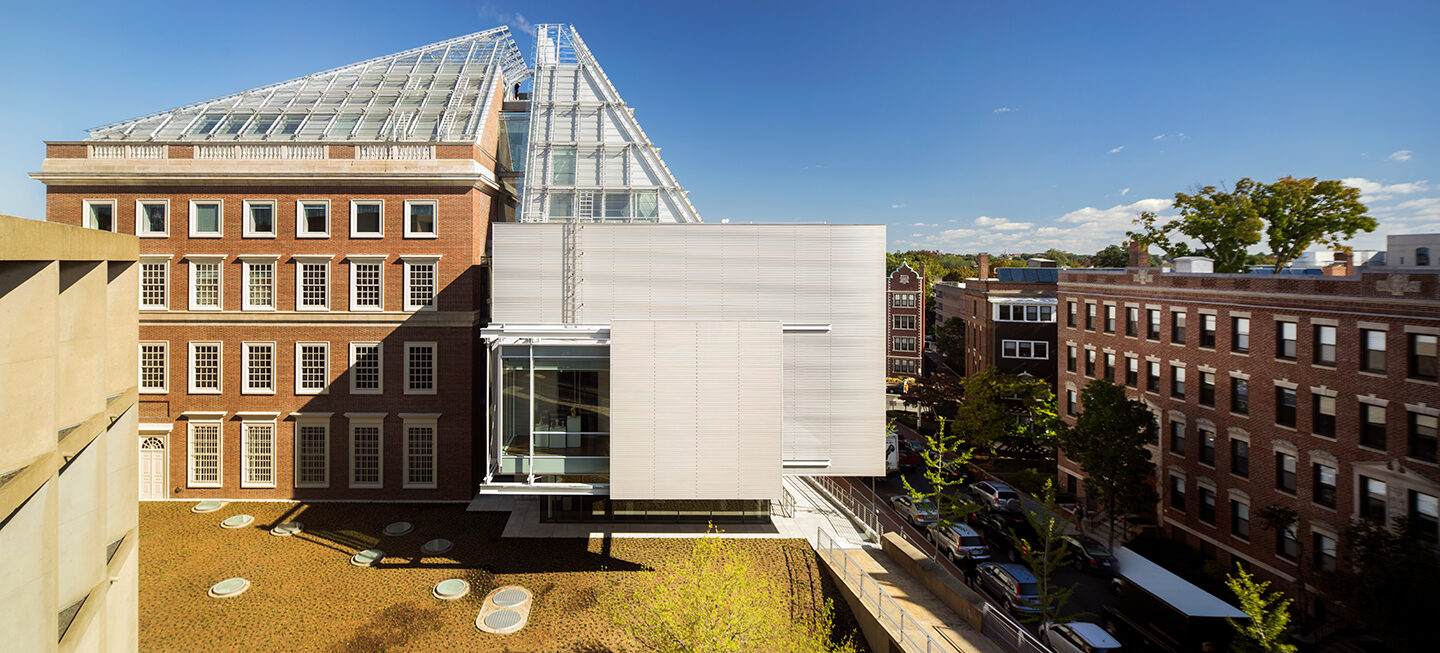The story of the Harvard Art Museums Renovation and Expansion, 2021 Harleston Parker winner

It’s not often that you’re able to visit three museums at the same time, but head over to Cambridge and that’s exactly what you’ll find near Harvard Square.
The Harvard Art Museums are a consolidation of Harvard’s three art collections: the Fogg Museum, the Busch-Reisinger Museum, and the Arthur M. Sackler Museum. While the three collections were once housed in separate buildings, a project intended to renovate and expand the former site of the Fogg Museum resulted in the unique new iteration, located on Quincy Street.
“One of the missions the project set out to do was to make the circulation more coherent, more understandable,” said Charles Klee AIA. “That’s another thing that’s maybe a little unique to this building. A lot of museums these days have become circuitous and complicated to move through … I think the building uses the central courtyard as an organizing tool to make sure you’re never lost, and I think it’s very successful in that respect.”
Klee is principal at Payette, the firm that headed the project in Cambridge. Renzo Piano Building Workshop worked in collaboration with Payette to create this museum, the winner of the 2021 BSA Harleston Parker Medal. The Harleston Parker, the highest honor awarded by the BSA, is given once annually to the “most beautiful” building, monument, or structure in Boston.
“We’re just tickled pink to have been granted the award—it’s really a recognition of something we, as a team, have devoted an enormous amount of energy to,” Klee said. “We think of it as kind of a once-in-a-lifetime project.”

Plans for the project began back in 2002, when the university decided that showing all three of its collections together would allow for a better gallery experience.
“We’d always had one administration for the three institutions, but we were never able to show all the collections together,” said Maureen Donovan, deputy director of the Museums. “One of the real goals of the project was to show our collections in dialogue with one another.”

The project began by enlisting the services of the Renzo Piano Building Workshop (RPBW), where renowned architect Renzo Piano headed a team that spanned two continents—from the Workshop’s headquarters in Genoa, Italy to Payette’s office in Boston.
“Renzo treated the team as one firm,” said Klee. “There were no boundaries, really, between us … We really operated cohesively as one.”
In a statement, Renzo Piano said, "Architecture is amazing—it is art, fed daily by real life. When looking at the Harvard Art Museums, I see an open and inviting building, flirting with light. This creates curiosity, which is often the beginning of a cultural attitude. In this building, diversity becomes a value; a place for urbanity. Buildings such as the Harvard Art Museums are shelters for both communities and society at large. They are places for a better world that answer not only to the needs and necessities of the institution, but also to the desires, dreams and aspirations of people."
"This is how architecture becomes a mirror of society—with beautiful places that tell stories," Piano continued. "This beauty makes us better people, switching on a light in our eyes making better cities. And better cities make better citizens."
The project was a new, but not unwelcome, challenge for both Piano and Payette. “We’d done a little [historic preservation] before, but this was taking it to a different notch, and it was also a new experience for Renzo … he’d done historic preservation in Italy, where they have a very different approach to doing this that’s maybe a little bit more bold than the US would accept,” said Klee.
Because the original Fogg building is a historically protected Georgian revival structure originally built in the 1920s, embarking on the expansion necessitated navigating the requirements of the Cambridge Historical Commission and the Massachusetts Historical Commission, and following the Secretary of the Interior’s standards for historic buildings nationwide. However, this didn’t stop Payette and Piano from seeking to innovate and push boundaries whenever possible.
“One of the things that I found extraordinary about Renzo Piano—and I don’t know how many other architects would do it—is the fact that he would build full-scale models of things that he wanted to think about or test,” said Donovan. “He just thought about context so much.”
“It’s that attention to detail, and not being satisfied with the first approach– it’s amazing how many things just kept evolving and evolving because he wanted to get it right,” added Daron Manoogian, Director of Communication at the Museums.

Klee remembers well the process of building and testing models, particularly with the glass lantern system.
“We mocked it up very early in the schematic design,” said Klee. “We flew out [to Genoa] with the conservators who were going to live under this glass roof, and they were concerned about this environment, and whether they were going to be able to control the light.”
The team came up with an idea to shingle the glass for the roof and add a triangular profile to the edge to facilitate water drainage, but when they gathered to view the mock-up in the bright light, a significant flaw became glaringly obvious.
“There were rainbows all over the ground, because of the triangular profile,” Klee recalled. “We should have thought of that, but that’s why you build a mock-up, because you don’t always think of these things. The rainbows would kill the conservation lab–you can’t have rainbows across the painting you’re trying to conserve.”

The team developed a new square edge for the glass, but that brought its own problems when the next mock-up was constructed. When water was sprayed on the model as part of a test, some of it was able to get through the roof. While reassessing in Boston, the designers came up with a more low-tech way to test glass samples.
“We built a little assembly with Velcro and put Velcro strips on our glass samples,” Klee said, “and then we went into the shower in our bathroom and tested overlaps … and we basically looked at every slope of the roof [to find] how much overlap we needed in order to ensure 100 percent drainage. And that testing system proved effective!”
The conservation lab’s glass roof was a consequence of Piano’s focus on allowing natural light into the space.
“He uses light as a design element,” Klee said. “Breathing light into this building was the thing that he felt was of the utmost importance.”
The use of glass and the incorporation of natural light had the effect of making the building much more welcoming.
“The building, before renovation, looked like an academic bunker,” Donovan said wryly. “There was no way of knowing what it was. You can now actually see it from the street and look into galleries.”
The wood façade of the building was another element of the design that required thorough testing and consideration.
“Wood was something that Renzo fell in love with very quickly when he first came to Boston and tried to take in the genetics of the city,” said Klee. “The clapboard siding that is traditional to all of our housing was something that really resonated for him as being unique, so he wanted early on to find a way to bring that to this project.”
Rod Anthony of Anthony Associates, a wood scientist, was brought in to help investigate how to build a wood system that could also serve as a high-performance rain screen. Ultimately the team selected Alaska yellow cedar to create the facade, choosing it for its thickness and resilience. A mock-up was built and allowed to age for 18 months, which allowed the team to observe the material’s durability and physical changes over time.

Another prominent feature of the museum is the courtyard, which serves as a central element around which the museum is oriented.
“The courtyard is the centerpiece of accessibility, inviting the public into the building,” said Manoogian. “Renzo really sold us on how he envisioned that space to work, and it really has come to fruition. People gather there– when you come into the building, it’s just this inviting space from where you can see art from so many different angles.”
“I’m sure there are people in the neighborhood that simply
come in to drink coffee in the courtyard and never go into the
galleries,” Donovan said, laughing, “but that’s okay too!”
There was a concentrated effort to make the museum building a community space, which is exemplified by a new entrance that faces Cambridge and Broadway.
“We became more transparent to the public, to the community, and the university as well,” Donovan said.
The addition of cafe tables has also been a welcome new element.
“Renzo kept talking about this courtyard as a piazza—and the thing about a piazza is that there’s always cafe tables. There’s always people at them. They can’t be quiet spaces—they’re actually alive,” said Klee.
The renovation hasn’t just brought the surrounding community into the museum space. It’s also created ties between the Museum, Payette, and RPBW that remain strong to this day.
“We still really love each other,” Donovan said, mentioning an event hosted by Payette this past summer that served as a reunion between the Museum staff and the project team at the firm. “People still talk about this project as being the best thing they’ve ever worked on—the most interesting, the most satisfying, the project that they’ll never have again.”
View more photos from the renovation and expansion project.
Think you know another building that deserves the Harleston Parker? Nominations for the 2022 award are open now.

